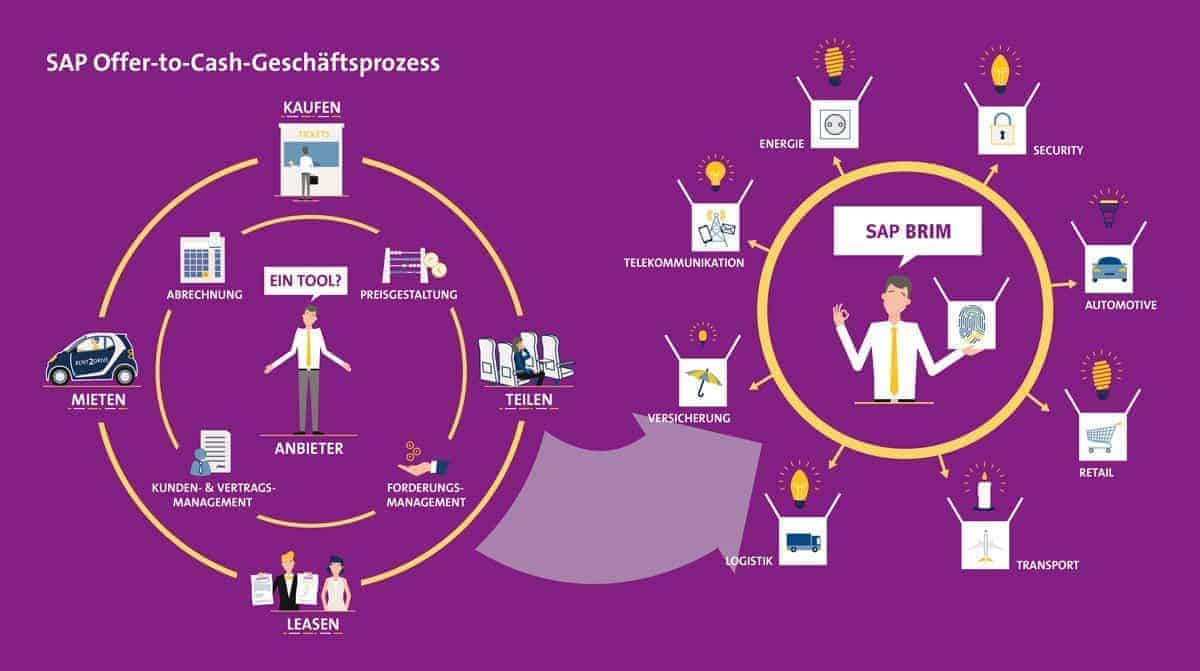Industry Use Cases for SAP BRIM


SAP BRIM offers comprehensive functionalities spanning subscription and order billing, flexible pricing, automated and convergent invoicing, and personalized payment processing to establish digital business models and optimize new processes.
The component ‘Contract Accounts Payable and Receivable’ (SAP FI-CA) includes a subledger which was specifically developed for industries with a huge customer base and subsequently a lot of billing processes involving mass data processing. Therefore, SAP BRIM is ideal for industries like insurance, utilities, telecommunication, media as well as the public sector.
Examples of energy and utilities
Energy and utility providers need to be able to offer more than just electricity, gas and water. Usage data are transferred and billed through smart metering systems in almost real time. It can be differentiated between on-peak and off-peak usage because time stamps and current type are also transferred to BRIM.
If a customer decides to charge their electric car, bike or scooter, these new usage data can be priced and billed in real time and are automatically added to the monthly invoice, regardless of payment methods (credit card, cash, app platforms, and others).
If the service provider is also a telecommunication or smart home solution provider, the billing data can be combined in one invoice. This means higher levels of transparency for customers because their actual usage data are detailed in one invoice. The undeniable benefit of BRIM – next to SAP FI-CA – is the integration of SAP CRM to individually collect conditions, prices and promotions for SAP Convergent Charging to analyze and leverage for pricing decisions. Additionally, SAP offers components for e.g. necessary market communication or intelligent measuring devices.
Rent, lease, and share
There’s almost no product or service that can’t be rented. This business model is ideal for BRIM’s customer-specific billing capabilities. With BRIM, rental companies can bill their services in real time or based on usage data collected by sensors.
For example, if a customer rents an excavator plus driver, the rental company can equip the excavator with a sensor collecting usage data. These data are sent to BRIM and billed in the system. Furthermore, the need for maintenance can be evaluated in real time.
Rented or leased machines can therefore not only be billed based on usage, but e.g. also based on spindle rotations. Even expensive tools like drills are often rented instead of purchased. Equipped with a measuring device, customers are either billed based on leasing rates or rotations. BRIM supports almost any new ideas concerning renting and leasing models.
Leased printers or plotters are often billed based on usage. Customers for example pay a flat rate for 10,000 printouts, and any copies after that are billed individually—no problem for BRIM. Another example would be the sharing economy, e.g. platforms for carsharing or e-scooter sharing or providers of comprehensive mobility platforms.

Individual billing
Thanks to its high flexibility and modular adaptability, SAP BRIM is ideal for internet or collaboration platforms and startups. Companies wanting to tackle digital transformation will find even more use cases for BRIM, for example switching from a traditional hardware-focused business to a digital service provider.
Furthermore, BRIM is useful for procurement platforms because it simplifies billing for both B2B customers and individual users.
Ideas and use cases
The use cases detailed above highlight how flexible and adaptable BRIM is. BRIM’s flexibility is not limited to its modular use, but also pertains to its many different uses in almost all industries. If customers have an idea about making a product into a service, or for a new sharing model or subscription service, we can help make that idea a reality with BRIM.
Industries
GTW industry examples of business models that can be realized or have already been realized with BRIM:
- Telecommunications service provider: Billing of prepaid and postpaid products as well as calls, SMS, MMS, Internet
- Sharing economy: time-based rental of cars, motorcycles, bicycles, scooters, etc.
- Road tolls: automatic billing of road tolls based on traveled kilometers
- Software licenses: Billing of licenses for software with different subscriptions - e.g. one-time 1-month trial, monthly/annual subscription
- Online storage is the same as cloud storage: subscriptions with different prices that are billed depending on the size of the storage and the contract term.
- Public transport: train, bus and streetcar journeys: individual tickets and monthly/annual subscriptions can be billed in BRIM
- E-mobility: charging stations
- Rental of systems and devices: Printers, machines and robots can be billed according to the actual operating hours used.
- Household appliances: Remote maintenance
- Buying a car: GPS, assistance systems, maintenance, breakdown assistance
- Platform business models: Service providers and customers meet on one platform
The advantages of SAP BRIM at a glance
Shorter time to market for products based on subscriptions and usage-based services or physical goods that are bundled with services:
- Flexible processing of revenue sharing models
- Realization of hybrid prepaid, postpaid and pay-as-you-go business models
- Rule-based and intelligent automation of invoicing and accounting processes
- Automated and highly efficient processing of high data volumes
- High transparency/traceability of the entire billing process chain - from usage events to invoicing
- Reduction of operating costs through consolidated billing systems
- Increase customer satisfaction by displaying costs, services and physical goods on a single invoice








